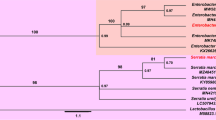Abstract
The larvicidal activity of extracellular metabolites of keratinophilic fungus Trichophyton mentagrophytes against Aedes aegypti larvae was determined. T. mentagrophytes was isolated from soil by the feather baiting technique. Culture filtrates (10–100 μL/mL) were found to be entomotoxic to 3rd instars larvae of A. aegypti (L3), LC50 and LC90 being 110 ± 11.5 and 200 ± 20.7 μL/mL, respectively, after 2 d. Extracellular metabolites are proteinaceous in nature and more specific to chitin of mosquito larvae. They degraded cock feather causing an average of 20.0 ± 2.6 % loss in feather mass. Culture filtrate at 100 μL/mL produced 90 % mortality against L3 after 3 d; mortality was increased in dose- and time-dependent manner. These extracellular metabolites of T. mentagrophytes could be regarded as alternatives to synthetic insecticides.
Similar content being viewed by others
Abbreviations
- SDA:
-
Sabouraud dextrose agar
- L3:
-
3rd instars larvae (of A. aegypti)
References
Anbu P., Hilda A., Gopinath S.C.B.: Keratinophilic fungi of poultry farm and feather dumping soil in Tamil Nadu, India. Mycopathologia158, 303–309 (2004).
Anbu P., Hilda A., Sur H.W., Hur B., Jayanthi S.: Extracellular keratinase from Trichophyton sp. HA-2 isolated from feather dumping soil. Internat.Biodet.Biodegr., in press (2008).
Apprich V., Spergser J., Rosengarten R., Stanek C.: In vitro degradation of equine keratin by dermatophytes and other keratinophilic fungi. Vet.Microbiol.114, 352–358 (2006).
CDC (Centres for Disease Control and Prevention). Available at http://www.cdc.gov/ncidod/dvbid/dengue/dengue-qa.html and http://www.cdc.gov/ncidod/dvbid/Chikungunya/CH_SymptomsTreatment.html; accessed on January 30, 2008.
Choochote W., Tuetun B., Kanjanapothi D., Rattanachanpichai E., Chaithong U., Chaiwong P., Jitpakdi A., Tippawangkosol P., Pitasawat B.: Potential of crude seed extract of celery, Apium graveolens L., against the mosquito Aedes aegypti (L.) (Diptera:Culicidae). J.Vect.Ecol.29, 340–346 (2004).
Das B.P.: Chilodonella uncinata — a protozoa pathogenic to mosquito larvae. Curr.Sci.85, 483–489 (2003).
Deshmukh S.K., Mandeel Q.A., Verekar S.A.: Keratinophilic fungi from selected soils of Bahrain. Mycopathologia165, 143–147 (2008).
Dixit A.K., Kushwaha R.K.: Occurrence of keratinophilic fungi on Indian birds. Folia Microbiol.36, 383–386 (1991).
Ellis D.: Practical identification of common dermatophytes. Available at http://www.mycology.adelaide.edu.au/Fungal_Descriptions/Dermatophytes/Trichophyton/mentagrophytes.html; accessed on January 15, 2008.
Finney D.J.: Probit Analysis, 3rd ed. Cambridge University Press, London (UK) 1971.
Gaikwad S.H.: Malaria/mosquito management: a need to use more than one insecticide alternatively. Curr.Sci.75, 79 (1998).
Gardner J.M., Pillai J.S.: Tolypocladium cylindrosporum (Deuteromycotina:Moniliales), a fungal pathogen of the mosquito Aedes australis. Mycopathologia97, 77–82 (1987).
Garga P., Nagpal J., Khairnar P., Seneviratne S.L.: Economic burden of dengue infections in India. Trans.Roy.Soc.Trop.Med. Hyg.102, 570–577 (2008).
Hag E.A., Nadi A.H., Zaitoon A.A.: Toxic and growth retarding effects of three plant extracts on Culex pipens larvae (Diptera: Culicidae). Phytother.Res.13, 388–392 (1999).
Hoti S.L., Balaraman K.: Method for storing Lagenidium (Oomycetes:Lagenidiales). Ind.J.Med.Res.95, 95–98 (1992).
Jain P.C., Agrawal S.C.: A note on the keratin decomposing capability of some fungi. Trans.Mycol.Soc.Japan21, 513–517 (1980).
Johri B.N.: Biology of dermatophytes and other keratinophilic fungi. Curr.Sci.84, 945–946 (2003).
Khanam S.J.P., Agrawal S.C., Jain P.C.: Keratin degrading and enzyme ability of fungi from soil. Ind.J.Microbiol.44, 261–264 (2004).
Kirschbaum J.B.: Potential implication of genetic engineering and other biotechnologies to insect control. Ann.Rev.Entomol.30, 51–70 (1985).
Kunert J.: The digestion of human hair by the dermatophyte Microsporum gypseum in a submerged culture. Mykosen15, 59–71 (1972).
Mcbride W.J.H., Ohmann H.B.: Dengue viral infections; pathogenesis and epidemiology. Microb.Infect.2, 1041–1050 (2000).
Mirsha S.K., Keller J.E., Miller J.R., Heisey R.M., Nair M.G., Putnam A.R.: Insecticidal and nematicidal properties of microbial metabolites. J.Industr.Microbiol.2, 267 (1987).
Mohanty S.S., Prakash S.: Laboratory evaluation of Trichophyton ajelloi, a fungal pathogen of Anopheles stephensi and Culex quinquefaciatus. J.Am.Mosq.Con.Assoc.16, 254–257 (2000).
Mohanty S.S., Prakash S.: Fungal culture filtrate of Trichophyton ajelloi against Anopheles stephensi and Culex quinquefaciatus larvae. Curr.Sci.86, 323–325 (2004).
Rai M.K., Qureshi S.: Screening of different keratin baits for isolation of keratinophilic fungi. Mycoses37, 295–298 (1994).
Reinert S.F., Harbacch R.E., Kitching I.J.: Phylogeny and classification of Aedini (Diotirae:Culicidae) based on morphological character of all stages. Zoo.J.Linn.Soc.142, 289–368 (2004).
Riddell R.W.: Slide culture technique, pp. 263–264 in G.S. Germain, K. Summerbell (Eds): Identifying Filamentous Fungi: a Clinical Laboratory Handbook. Star Publ. Co., Belmont (CA, USA) 1996.
Sharma V.P.: Dengue hemorrhagic fever epidemic in Delhi. Cur.Sci.72, 10–11 (1997).
Townsona H., Nathan M.B.: Resurgence of chikungunya. Trans.Roy.Soc.Trop.Med.Hyg.102, 308–309 (2008).
Vijayan V., Balaraman K.: Metabolites of fungi and actinomycetes active against mosquito larvae. Ind.J.Med.Res.93, 115–117 (1991).
Weiser J., Maťha V.: Tolypin, a new insecticidal metabolite of fungi of the genus Tolypocladium. J.Invertebr.Pathol.51, 94–96 (1988).
Weiser J., Maťha V., Jegorov A.: Tolypocladiun terricola sp., a new mosquito-killing species of the genus Tolypocladium GAMS (Hyphomycetes). Folia Parasitolol.38, 363–369 (1991).
Žižka J., Weiser J.: Effect of beauvericin, a toxic metabolite of Beauveria bassiana, on the ultrastructure of Culex pipiens autogenicus larvae. Cytobios75, 13–19 (1993).
Author information
Authors and Affiliations
Corresponding author
Rights and permissions
About this article
Cite this article
Murugesan, A.G., Sathesh Prabu, C. & Selvakumar, C. Biolarvicidal activity of extracellular metabolites of the keratinophilic fungus Trichophyton mentagrophytes against arvae of Aedes aegypti — a major vector for Chikungunya and dengue. Folia Microbiol 54, 213–216 (2009). https://doi.org/10.1007/s12223-009-0034-5
Received:
Revised:
Published:
Issue Date:
DOI: https://doi.org/10.1007/s12223-009-0034-5




